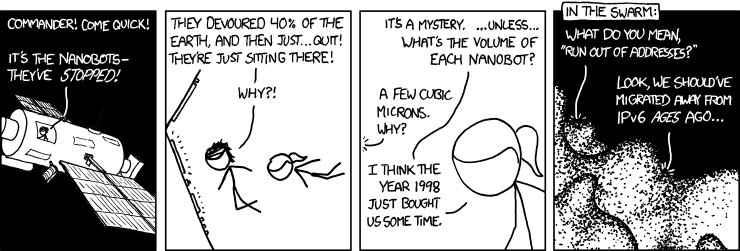
Up to now in my career I’ve been able to avoid IPv6, but I guess it’s time I faced the inevitable. IPv4 address exhaustion is upon us, and IPv6 adoption is creeping up: Google’s stats show a gradual increase in IPv6 connectivity, although IPv6 traffic is still very low. I live in Belgium, which at the time of writing has the highest level of IPv6 capability on the planet.
The original motivation for IPv6 was to expand the address space: in place of IPv4’s 32-bit addresses, IPv6 addresses are 128 bits, providing 2128 addresses, that’s 340282366920938463463374607431768211456, or about 340 trillion trillion trillion. That’s enough for an entire IPv4 Internet for every star in the universe, or an IPv6 address for every atom on the surface of the earth (and more than a hundred other planets) or if every address was a picometer (1 trillionth of a meter) then the whole address space would stretch 34 billion light years (while the furthest visible object in the universe is 13 billion light years away).
Let’s take a look at how IPv6 addresses are represented. Here’s an example of an IPv6 address:
2001:db8:1234:5678:9012:3456:7890:1234
The 128 bits are represented in hex, separated into eight groups of sixteen bits by colons. Sometimes the groups of sixteen bits are referred to as “quartets” (e.g. Writing IPv6 Addresses – Presented by Cricket Liu) and sometimes as “hextets” (e.g. Coffeen 2014, Chapter 2). I’ll follow Tom Coffeen’s practice and refer to them as hextets.
In the example address that I gave you’ll notice that there are only three hex digits in the second hextet. Leading zeroes within a hextet may be omitted, so that “:db8:” stands for “:0db8:”. A single hextet of all zeroes i.e. “:0000:” can be represented as a single zero “:0:”. A sequence of consecutive all-zero hextets can be represented as “::”, so that:
2001:0db8:0000:0000:0000:0000:0000:0001
is represented as:
2001:db8::1
Since we know that an IPv6 address is 128 bits long, we can work out that there are five missing hextets that have been condensed down to a single “::”. At one point you could also condense a single hextet of all zeroes to “::” but RFC 5952 mandates the “:0:” format.
Things get more complicated if there are more than one sequence of consecutive all-zero hextets in the same IPv6 address. Here’s another address:
2001:0db8:0000:0000:0001:0000:0000:0001
You can’t contract both sequences because you might end up with an ambiguous address: how many hextets would be represented by each “::”? Earlier RFCs didn’t document how you should handle this. RFC 5952 stipulated that you should condense the longest sequence of all-zero hextets, and if the two sequences are the same length then you should condense the first one, so the above example address would be condensed to:
2001:db8::1:0:0:1
RFC 5952 makes the rules on condensing all-zero hextets mandatory, and also specifies that systems should display IPv6 addresses with lower-case letters. It advises humans to follow the same rules.
IPv6 prefixes are represented in much the same way as IPv4 prefixes in CIDR notation, so that:
2001:db8::/32
represents every address from:
2001:db8::
to:
2001:db8:ffff:ffff:ffff:ffff:ffff:ffff
In the next post I’ll take a look at the way IPv6 addresses are structured.
